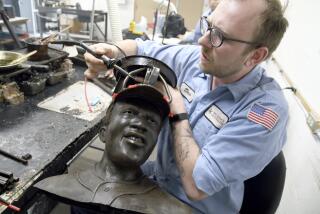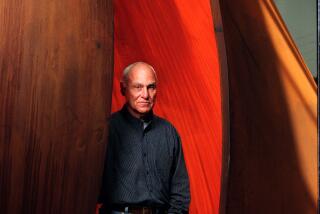Seeking a Sleeping Giant
- Share via
BAMIAN, Afghanistan — Archeologist Zemaryalai Tarzi can barely bring himself to look at the ravaged cliff face where two ancient Buddhas towered until the Taliban infamously blasted them to bits.
“For me, everything there is over,” Tarzi says, pointing toward the heap of peach-colored dust and chunks of rock that used to be one of the massive statues. “It hurts my heart to go there and see what has been lost.”
But the bespectacled scientist, who began his career in this sleepy valley in Afghanistan’s central highlands more than 35 years ago, isn’t letting the destruction get the best of him. He has turned his back on the cliff, stuck his trowel into the earth, and is on the hunt for a magnificent relic perhaps five times as large as the ones that incurred the Taliban’s wrath: the long-lost sleeping Buddha of Bamian.
“We are digging,” Tarzi says, “to find the greatest statue in the world.”
It’s hard to believe that the sculpture ever went missing. According to the writings of a Chinese pilgrim who reported seeing the reclining Buddha in AD 629, it stretched 1,000 feet.
Today, the pilgrim’s brief, 1,375-year-old account remains the most detailed description of the sleeping Buddha. Probably constructed in the late 6th century, the statue hasn’t been seen in hundreds of years. And even experts who believe the sculpture exists doubt it is -- or was -- more than three football fields long.
If Tarzi succeeds in locating it, the discovery will mean more than uncovering the largest known statue of Buddha. It could be a psychic balm and a financial boon for Afghanistan, easing a collective guilt over the Taliban’s destructive acts and reviving Bamian’s fortunes as the tourism capital of the nation.
Already, the town of about 40,000 has started picking up the pieces of its pulverized history and economy. Backpackers are trickling back to the grimy inns behind the newly constructed bazaar, built to replace one razed by the Taliban. Upscale foreign travelers are reserving $50-a-night yurts at the reopened state-run tourist hotel.
Japanese specialists have surveyed the area’s famed cave artwork and are building an archeology research center. German experts have begun cataloging the massive chunks of the busted Buddhas as debate continues over whether and how to rebuild them. And ground will soon be broken on a museum.
But it is Tarzi’s mission that perhaps has sparked the highest expectations.
“If the reclining Buddha is found,” says Najaf Ali Ashana, general manager of the government-run Bamian Hotel, “Bamian will have its value again.”
The quest for the reclining Buddha is unfolding in nine pits a few hundred yards east of where the smaller of the two cliff statues stood. Seventy local men, paid about $3 a day, are busy shoveling dirt into wheelbarrows, digging with hand tools and picking away at promising areas with brushes and small instruments that look borrowed from a dentist’s office.
The excavation here began last summer and yielded several finds, the most significant being seven unbaked clay heads of Buddhist divinities, each about the size of a small melon. Tarzi believes that discovery confirms that he has found the so-called Eastern Monastery, where the pilgrim Xuanzang reported seeing the reclining Buddha.
The team has also found what seem to be several thick retaining walls. Though these could be for the monastery, Tarzi believes it is more likely that they belong to a huge covering that once shielded the sleeping Buddha.
“If you want to construct a wall that would support a massive structure, you would have to build it in this way,” Tarzi says, calculating that if the statue was in fact 1,000 feet long -- the length of a 100-story building tipped on its side -- its dimensions would necessitate a covering at least 30 feet high.
Other large statues of Buddha in the parinirvana pose exist in Thailand, Sri Lanka and other countries, though none come close to 1,000 feet. Smaller ones have been found elsewhere in Afghanistan. The posture depicts Buddha at age 80, reclining on his deathbed on his right side with his head pointing north, and entering into a state of final transcendence.
Should a reclining Buddha be found in Bamian, it is likely to be in very poor condition. Even the standing Buddhas, which were protected from the elements by their niches in the cliff, were severely weathered. A reclining Buddha, which could have been made of clay bricks rather than a base of solid rock, would have been even more exposed to the elements once any protective covering was destroyed.
“It is likely to be extremely eroded,” says Edmund Melzl, a German restorer working on conserving the pieces of the standing Buddhas. “Or people could have stolen the bricks and used them to build their houses.”
Tarzi harbors no illusions that he will unearth a gleaming gold giant. “It will be very degraded if we find it,” he says. “All I hope to find is perhaps the folds of garments, or other small parts. The extremities are almost certainly gone.”
Regardless of the sculpture’s condition, just searching for it is an opportunity the 65-year-old Tarzi never thought he would have.
After working throughout much of the 1970s as Afghanistan’s director of archeology and conservation of historical monuments, he fled to France when the Soviets invaded his country in 1979. Ten years of occupation led to another decade of factional fighting and Taliban rule. Tarzi became a French citizen and professor at the Marc Bloch University of Strasbourg.
“I turned the page on Afghanistan and never believed I would return,” says Tarzi, whose work has been funded by the French government for the last two years; National Geographic is also contributing.
The Taliban period was perhaps the hardest on the archeologist. Many objects he had unearthed, particularly at Hadda, near Jalalabad, were destroyed by the regime. The hard-line rulers ordered the smashing of all pre-Islamic relics, including Greek statues and figures of ancient royalty, on the grounds that such items were idolatrous.
“I suffered a lot after the destruction of the Buddhas and other monuments by the Taliban,” he says. “When an archeologist finds an object, it’s like having a child. We do everything we can to restore it, to preserve it, like a mother would do for a child. It’s a very special relationship.
“For me, it was like having 1,000 children. But they killed my children. Now, I’m trying not to be too attached here.”
Given its humble nature today, it is hard to believe that the Bamian valley was once home to opulent monuments. These days, it is dotted with mud-brick homes and covered in a patchwork quilt of potato and grain fields.
It is a quiet place, where muddy water trickles along narrow irrigation canals and breezes skirt through spindly trees, interrupted only by the occasional distant honking of a mule.
But in the 7th and 8th centuries, the town was a thriving crossroads for travelers voyaging along Silk Road routes to Rome, China and India. Its rise as a major center of Buddhism began perhaps as early as the 2nd century and lasted 700 years, until the arrival of Islam.
Although archeologists are still debating when the standing Buddhas were hewn out of the cliffs, Tarzi believes the reclining Buddha probably was constructed in the 6th century, about the same time the larger of the paired Buddhas may have been carved.
“A statue of 1,000 feet would have attracted the attention of other travelers before Xuanzang if it had been here,” therefore the great Buddhas were probably not built long before the Chinese traveler arrived in 629, Tarzi hypothesizes.
The experts who doubt that Bamian’s reclining Buddha could have been 1,000 feet long note that Xuanzang’s original text has never been found. Some suggest that an extra zero may have been added to his description of the Buddha’s dimensions as the document was copied and recopied and passed down through the centuries.
“I think 1,000 feet is not plausible, unless this was some kind of natural formation that was then turned into or regarded as a Buddha,” says Deborah Klimburg-Salter, an art history professor at the University of Vienna who has written extensively about Bamian. “If it was 1,000 feet, then it certainly wasn’t in a building.”
Xuanzang’s other observations, however, have proved most accurate. He recorded the height of Bamian’s larger standing Buddha as 140 to 150 feet; it was 180. And his description of a reclining Buddha at Kushinagar, India, led Sir Alexander Cunningham to uncover the 18-foot-long statue in 1876.
Tarzi insists that a vast sleeping Buddha isn’t out of the question. He notes that in other Buddhist centers where standing and reclining Buddhas have been found, the sleeping statues are always larger than the standing ones, and a mathematical formula dictates the various dimensions.
How, then, could such a large object go missing?
Klimburg-Salter says there is a chance that the long-lost Buddha may be entombed in rubble from the numerous earthquakes that have rattled Afghanistan over the centuries. Large chunks of the cliffs that housed the standing Buddhas have fallen, she notes, creating a layer of debris several yards thick. If the reclining Buddha was situated along the base of the cliff, it might simply be buried.
So Tarzi, four French graduate students and dozens of other men in the pits toil on optimistically.
On a recent Saturday, the excavation work proceeded as three black and white cows grazed on a neighboring plot. The most interesting thing that had turned up was a bullet.
Then, in one of the cavities, a little whoop. Tarzi scrambled off his maroon plastic patio chair and plunged into the pit. A worker brushing dirt away from one of the suspected retaining walls pointed to some black residue amid the tan clay.
“Fire!” Tarzi said, his eyebrows arching dramatically.
Could this be evidence of the blaze set by the Islamic invader Yacub bin Lays Safari, who rode into Afghanistan in the 9th century and sacked and torched much of what he found, including Bamian?
The question hung in the air. The sun began its descent, casting a hazy glow over the landscape. The men gathered up their tools.
The find, recorded in a notebook, would be added to a few other minute clues gathered that day, including some small pottery shards and a pocket of unusual green clay.
By the end of the month, Tarzi will have to wrap up his work in Bamian for the year, because his students will return to school and snows are expected as early as October. He doesn’t yet know whether his funding will be renewed, but he is determined to return next year to continue his search.
“I do not want to dig just to wash away the shame of the Taliban,” he said. “I am doing this for the people of Bamian, and because I love what I am doing. Bamian is part of my country, and when I die, part of me will be here.”
More to Read
Sign up for Essential California
The most important California stories and recommendations in your inbox every morning.
You may occasionally receive promotional content from the Los Angeles Times.










